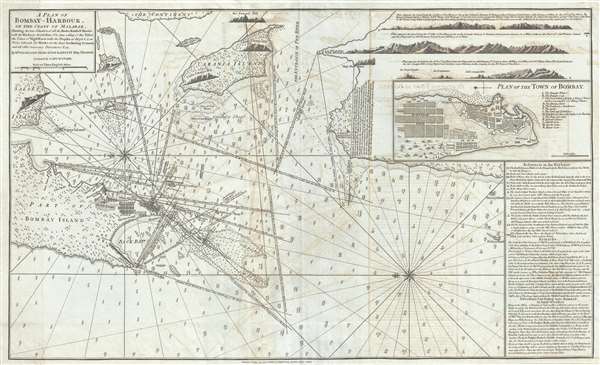This item has been sold, but you can get on the Waitlist to be notified if another example becomes available, or purchase a digital scan.
1794 Laurie and Whittle Nautical Map of Bombay Island and Harbor, India
Bombay2-lauriewhittle-1794
Title
1794 (dated) 20 x 28.5 in (50.8 x 72.39 cm) 1 : 50000
Description
The earliest known published map of Bombay is the Seller map of 1685. That map formed the basis for all subsequent maps of Bombay, including the Van Keulen. In 1768, Captain William Nicholson was commissioned by the British East India Company to resurvey the increasingly busy harbor. His great chart, a massive eight sheet draught, was published by John Spilsbury in 1768. That map now exists in only a single incomplete example in the Library of the Greenwich Maritime Museum. Spilsbury's draught fell into the hands of map publisher Robert Sayer, who produced a smaller version of the map in 1778. Sayer's business, including the plates for this map, were acquired by Laurie and Whittle, who issued a new edition, based upon the updated Bombay Marine surveys of Captain John Watson, in 1794 – the present example. Thus, there are three major episodes in mapping of Bombay: the British East India Company survey that resulted in the 1685 Seller (later republished by Thornton), the 1768 Nichelson/Spilsbury survey, and the present example, the 1794 Watson/Laurie and Whittle update.
The map offers rich detail including countless depth soundings, notes on the sea floor, commentary on reefs, rhumb lines, shoals, place names and a wealth of other practical information for the mariner. Though most charts in Laurie and Whittle's East-India Pilot were derived from earlier maps prepared for Jean-Baptiste d'Apres de Mannevillette's 1745 Neptune Oriental, this particular chart is a new and uniquely British production. Cartographically it was derived from surveys by Captain William Nicholson and Captain Watson. This map was registered by Laurie and Whittle from their offices at 53 Fleet Street, London, on May 12, 1794.
Cartographer
Laurie and Whittle (fl. 1794 - 1858) were London, England, based map and atlas publishers active in the late 18th and early 19th century. Generally considered to be the successors to the Robert Sayer firm, Laurie and Whittle was founded by Robert Laurie (c. 1755 - 1836) and James Whittle (1757-1818). Robert Laurie was a skilled mezzotint engraver and is known to have worked with Robert Sayer on numerous projects. James Whittle was a well-known London socialite and print seller whose Fleet Street shop was a popular haunt for intellectual luminaries. The partnership began taking over the general management of Sayer's firm around 1787; however, they did not alter the Sayer imprint until after Sayer's death in 1794. Apparently Laurie did most of the work in managing the firm and hence his name appeared first in the "Laurie and Whittle" imprint. Together Laurie and Whittle published numerous maps and atlases, often bringing in other important cartographers of the day, including Kitchin, Faden, Jefferys and others to update and modify their existing Sayer plates. Robert Laurie retired in 1812, leaving the day to day management of the firm to his son, Richard Holmes Laurie (1777 - 1858). Under R. H. Laurie and James Whittle, the firm renamed itself "Whittle and Laurie". Whittle himself died six years later in 1818, and thereafter the firm continued under the imprint of "R. H. Laurie". After R. H. Laurie's death the publishing house and its printing stock came under control of Alexander George Findlay, who had long been associated with Laurie and Whittle. Since, Laurie and Whittle has passed through numerous permeations, with part of the firm still extant as an English publisher of maritime or nautical charts, 'Imray, Laurie, Norie and Wilson Ltd.' The firm remains the oldest surviving chart publisher in Europe. More by this mapmaker...

